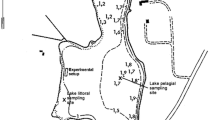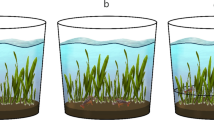Abstract
Restoration of shallow lakes to a clear-water state, often characterized by high submerged macrophyte cover and a high proportion of piscivores such as perch, Perca fluviatilis L., frequently involves removal of a large proportion of the zoobenthivorous fish, such as bream, Abramis brama L., and roach, Rutilus rutilus L. (i.e. biomanipulation). However, establishment of submerged macrophytes is often delayed following fish removal. This is unfortunate because plant beds typically host high densities of the macroinvertebrates constituting the diet of small perch and thus help perch to go through the bottleneck from feeding on macroinvertebrates to feeding on fish. Establishment of artificial plant beds may be a useful tool to enhance macroinvertebrate population growth and thus food resources for small perch until the natural plants have established. To investigate this restoration option, we studied during two growing seasons (June–October) the composition and abundance of the macroinvertebrate community in artificial plant beds installed in shallow Lake Væng (Denmark) comprising the initial phase of a biomanipulation effort by fish removal. Lake areas with artificial plant beds exhibited substantially higher macroinvertebrate densities than the lake bottom. This suggests that artificial plant beds may be used as feeding grounds for small perch, similarly to the well-known refuge effect for zooplankton against fish predation. In this way, artificial plant beds could help maintain a clear-water state during the transient period when natural submerged vegetation is not yet established in the lake.





Similar content being viewed by others
References
Allen, K. R., 1935. The food and migration of the perch (Perca fluviatilis) in Windermere. Journal of Animal Ecology 4: 264–273.
Ball, R. C. & D. W. Hayne, 1952. Effects of the removal of the fish population on the fish-food organisms of a lake. Ecology 33: 41–48.
Carpenter, S. R., J. F. Kitchell & J. R. Hodgson, 1985. Cascading trophic interactions and lake productivity. BioScience 35: 634–639.
Crowder, L. B. & W. E. Cooper, 1982. Habitat structural complexity and the interaction between bluegills and their prey. Ecology 63: 1802–1813.
Diehl, S., 1988. Foraging efficiency of three freshwater fishes: effects of structural complexity and light. Oikos 53: 207–214.
Gliwicz, Z. M. & A. Jachner, 1992. Diel migration of juvenile fish: a ghost of predation past or present. Archiv für Hydrobiologie 124: 385–410.
Hansson, L. A., H. Annadotter, E. Bergman, S. F. Hamrin, E. Jeppesen, T. Kairesalo, E. Luokkanen, P. A. Nilsson, M. Søndergaard & J. Strand, 1998. Biomanipulation as an application of food-chain theory: constraints, synthesis, and recommendations for temperate lakes. Ecosystems 1: 558–574.
Hargeby, A., G. Andersson, I. Blindow & S. Johansson, 1994. Trophic web structure in a shallow eutrophic lake during a dominance shift from phytoplankton to submerged macrophytes. Hydrobiologia 279(280): 83–90.
Hargeby, A., H. Blom, I. Gunnar & G. Andersson, 2005. Increased growth and recruitment of piscivorous perch, Perca fluviatilis, during a transient phase of expanding submerged vegetation in a shallow lake. Freshwater Biology 50: 2053–2062.
Jeppesen, E., M. Søndergaard, J. P. Jensen, K. E. Havens, O. Anneville, L. Carvalho, M. F. Coveney, R. Deneke, M. T. Dokulil, B. Foy, D. Gerdeaux, S. E. Hampton, S. Hilt, K. Kangur, J. Köhler, E. H. H. R. Lammens, T. L. Lauridsen, M. Manca, M. R. Miracle, B. Moss, P. Nõges, G. Persson, G. Phillips, R. Portielje, C. L. Schelske, D. Straile, I. Tátrai, E. Willén & M. Winder, 2005. Lake responses to reduced nutrient loading – an analysis of contemporary long-term data from 35 case studies. Freshwater Biology 50: 1747–1771.
Jespersen, A. M. & K. Christoffersen, 1987. Measurements of chlorophyll-a from phytoplankton using ethanol as extraction solvent. Archiv für Hydrobiologie 109: 445–454.
Lammens, E. H. R. R., 1999. The central role of fish in lake restoration and management. Hydrobiologia 395/396: 191–198.
Lauridsen, T. L., J. P. Jensen, E. Jeppesen & M. Søndergaard, 2003. Response of submerged macrophytes in Danish lakes to nutrient loading reductions and biomanipulation. Hydrobiologia 506(509): 641–649.
Leppä, M., H. Hämäläinen & J. Karjalainen, 2003. The response of benthic macroinvertebrates to whole-lake biomanipulation. Hydrobiologia 498: 97–105.
Liboriussen, L., E. Jeppesen, M. E. Bramm & M. F. Lassen, 2005. Periphyton–macroinvertebrate interactions in light and fish manipulated enclosures in a clear and a turbid shallow lake. Aquatic Ecology 39: 23–39.
Marklund, O., I. Blindow & A. Hargeby, 2001. Distribution and diel migration of macroinvertebrates within dense submerged vegetation. Freshwater Biology 46: 913–924.
Mehner, T., 2010. No empirical evidence for community-wide top-down control of prey fish density and size by fish predators in lakes. Limnology and Oceanography 55: 203–213.
Okun, N. & T. Mehner, 2005. Distribution and feeding of juvenile fish on invertebrates in littoral reed (Phragmites) stands. Ecology of Freshwater Fish 14: 139–149.
Persson, L. & L. A. Greenberg, 1990. Juvenile competitive bottlenecks: the perch (Perca fluviatilis)–roach (Rutilus rutilus) interaction. Ecology 71: 44–56.
Pinder, L. C. V., 1992. Biology of epiphytic Chironomidae (Diptera: Nematocera) in Chalk Streams. Hydrobiologia 248: 39–51.
Schou, M. O., C. Risholt, T. L. Lauridsen, M. Søndergaard, P. Grønkjær, L. Jacobsen, S. Berg, C. Skov, S. Brucet & E. Jeppesen, 2009. Restoring lakes by using artificial plant beds: habitat selection of zooplankton in a clear and a turbid shallow lake. Freshwater Biology 54: 1520–1531.
Søndergaard, M., E. Jeppesen, T. L. Lauridsen, C. Skov, E. H. van Nes, R. Roijackers, E. Lammens & R. Portielje, 2007. Lake restoration: successes, failures and long-term effects. Journal of Applied Ecology 44: 1095–1105.
Søndergaard, M., L. Liboriussen, A. R. Pedersen & E. Jeppesen, 2008. Lake restoration by fish removal: short- and long-term effects in 36 Danish lakes. Ecosystems 11: 1291–1305.
Svensson, J. M., E. Bergman & G. Andersson, 1999. Impact of cyprinid reduction on the benthic macroinvertebrate community and implications for increased nitrogen retention. Hydrobiologia 404: 99–112.
Tolonen, K. T., J. Karjalainen, S. Staff & M. Leppä, 2000. Individual and population-level food consumption by cyprinids and percids in a mesotrophic lake. Ecology of Freshwater Fish 9: 153–162.
Winfield, I. J., 1986. The influence of simulated aquatic macrophytes on the zooplankton consumption rate of juvenile roach, Rutilus rutilus, rudd, Scardinius erythrophthalmus, and perch, Perca fluviatilis. Journal of Fish Biology 29: 37–48.
Acknowledgments
We are thankful to Anne Birgitte Hundahl, Ayse Idil Cakiroglu, Carolina Trochine, Eçe Saraoglu, Elisabeth Jensen, Eti Levi, Frank Landkildehus, Kirsten Landkildehus Thomsen, Klaire Houeix, Korhan Özkan, Louise Nathansen, Lúcia Lobão, Marcelo Guerrieri, Nihan Yazgan, Sandra Brucet, Soledad García, Tine Nielsen, Tommy Silberg, Ulla Kvist Pedersen and Xristina Papadaki for their valuable help in the field. We also thank Søren Erik Larsen for statistical advice, Anne Mette Poulsen for editorial assistance, Tinna Christensen for layout assistance and Erling Pedersen for assistance in the preparation of the experiment. We also thank the anonymous reviewers who gave useful suggestions to improve this article. The study was supported by the Danish Centre for Lake Restoration (Clear—a Villum Kann Rasmussen Centre of Excellence project), EU-WISER and EU-REFRESH, the Research Council for Nature and Universe (272-08-0406) and project ENDURE (Marie Curie Individual Fellowship MEIF-CT-2006-038366).
Author information
Authors and Affiliations
Corresponding author
Additional information
Handling editor: Luis Mauricio Bini
Rights and permissions
About this article
Cite this article
Boll, T., Balayla, D., Andersen, F.Ø. et al. Can artificial plant beds be used to enhance macroinvertebrate food resources for perch (Perca fluviatilis L.) during the initial phase of lake restoration by cyprinid removal?. Hydrobiologia 679, 175–186 (2012). https://doi.org/10.1007/s10750-011-0867-1
Received:
Revised:
Accepted:
Published:
Issue Date:
DOI: https://doi.org/10.1007/s10750-011-0867-1




